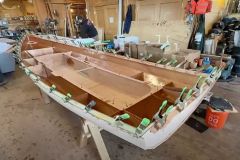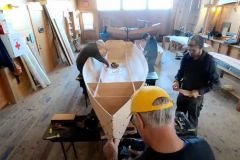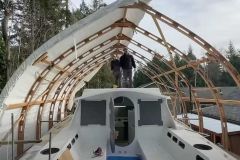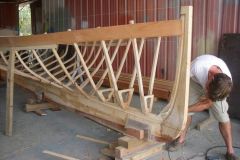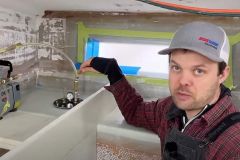Making bathroom furniture
Matt continues to transform his 60-foot Duracell into a cruising sailboat. Now that all the bulkheads are finished, it's time to fit out the bathroom. For aesthetic reasons, but also to avoid the risk of hurting himself on edges, Matt opted for curved corners with large radii. Working with foam-core composite sandwich, the aim is to shape the panel to this curve. He starts by making a sample so that he can measure exactly where the radius starts and see how the material takes shape. To do this, he cuts the inner skin and foam with a table saw. He then reproduces the operation on the panel cut from the template.
Once the sink plan and the various cupboards are in place, Matt closes the bathroom floors, gluing them in place and then reinforcing them with laminate. Access hatches will be installed at a later date.
A crack in the deck planking
Just as he was about to attack the workbench, after sanding the area, Matt discovers a crack in the deck planking. Probably caused by Duracell's dismasting, it's nothing to worry about in Matt's eyes. He performs vacuum lamination to reinforce the area.
Workbench manufacture
In today's second episode, Matt tackles the workbench. Essential when you sail your boat for a long time, this element is precious to Matt. He creates it with vertical supports in classic PET foam, but uses a core in Coosa Board, a fiber-reinforced high-density polyurethane foam. On top of this, he adds a sacrificial melamine top, which he can replace if necessary. Matt can then type and cut on his workbench without fear.
The area will also feature tool storage.




